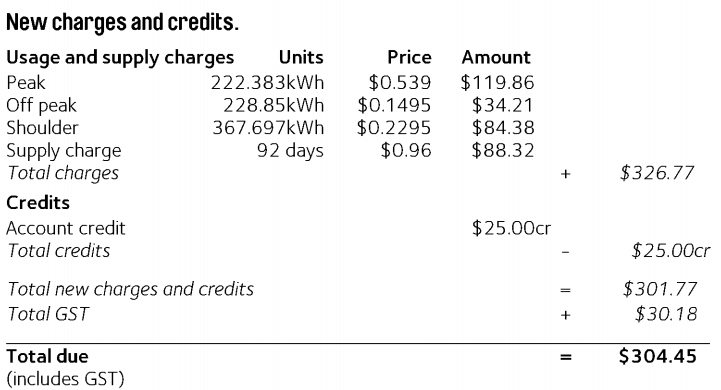Understanding peak electricity hours and off-peak electricity hours is crucial to reducing your overall power costs – provided these times and rates apply to you. Though when it comes to researching electricity, it’s easy to get confused by the energy-related jargon – with ‘peak’ and ‘off-peak’ being some of those most widely used but easily misunderstood terms.
In this guide, we’ll explain how peak and off-peak electricity rates differ, what times of day they apply and who actually pays these different charges.
On this page:
- What does ‘peak usage’ mean?
- How to check when electricity rates are peak and off-peak
- Peak and off-peak electricity times
- EnergyAustralia peak and off-peak electricity times
- AGL peak and off-peak electricity times
- Origin peak and off-peak electricity times
- Peak vs off-peak electricity prices
- Should I use peak and off-peak electricity rates?
What does ‘peak usage’ mean?
‘Peak usage’ will generally be seen on electricity bills, but this will mean different things to different customers, depending on the type of energy tariff.
- A single rate tariff is the same price for electricity regardless of what time of day it is used. However, energy retailers still refer to these prices as ‘peak usage’. This is especially true if you have a controlled load whereby you pay for hot water heating or your pool pump at a reduced rate.
- A time of use tariff means paying different prices for electricity depending on what time of day it is used. In this instance, the ‘peak usage’ component of the bill will reflect the amount of energy used during electricity peak hours.
Peak usage information and costs alongside all other cost details – including other tariffs – can be found on the electricity bill. In the case of a household on a single rate tariff, the peak usage component will simply reflect all energy usage (with the exception of a controlled load, if applicable). Those on a time of use tariff will see peak usage costs next to off-peak and ‘shoulder’ costs (the time between peak and off-peak hours, if applicable), as well as daily supply charges.
The below example is an AGL bill for a household with a time of use tariff.

How to check when electricity rates are peak and off-peak
Peak and off-peak electricity rates are only applicable for those signed up to a ‘time of use’ or ‘flexible pricing’ tariff. To do this, a smart meter must be installed at the property.
Electricity users will only be on a time of use tariff if they have discussed the option with their energy retailer and believe it will prove financially beneficial (i.e. generally using more power during the day or late at night rather than the early evening). Canstar Blue research has shown that time of use tariffs can prove a costly mistake if energy usage habits don’t correlate appropriately.
Those on a single rate tariff could incorrectly be thinking that they are paying different rates for power throughout the day and therefore delaying household appliance use for no reason. The reality is that the vast majority of Australian households are on a single rate tariff.
If you’re not sure which tariff you’re on, check your electricity bill or contact your energy retailer.
Peak and off-peak electricity times
Peak, off-peak and shoulder electricity usage times vary between energy retailers and states, but as a general guide, we have listed times for AGL, Origin and EnergyAustralia below. If you’re with a different retailer, you can check their peak and off-peak usage times and charges by reviewing their energy price fact sheets.
EnergyAustralia peak and off-peak electricity times

Here are the peak, off-peak and shoulder periods offered by EnergyAustralia on a time of use tariff in each state. Please note that these time periods may change in the future which is why it’s always best to refer to the energy price fact sheets.
Victoria (Citipower)
- Peak: 3pm to 9pm every day
- Shoulder: Not applicable
- Off-peak: 9pm to 12am and 12am to 3pm everyday
New South Wales (Ausgrid)
In New South Wales, EnergyAustralia goes a step further and offers peak and off-peak electricity rates which differ between the summer and winter months. This is known as a seasonal time of use tariff.
Summer (1 Nov to 31 Mar):
- Peak: 2pm to 8pm on weekdays
- Shoulder: 7am to 2pm and 8pm to 10pm on weekdays, 7am to 10pm weekends
- Off-peak: 10pm to 7am everyday
Winter (1 Jun to 31 Aug):
- Peak: Not applicable
- Shoulder: 7am to 10 pm everyday
- Off-peak: 10pm to 7am everyday
Non Summer/Non Winter (1 Apr to 31 May and 1 Sep to 31 Oct):
- Peak: Not applicable
- Shoulder: 7am to 10 pm everyday
- Off-peak: 10pm to 7am everyday
South East Queensland (Energex)
EnergyAustralia doesn’t currently offer a time of use tariff to its South East Queensland customers. It does however offer a demand tariff, which has a peak time from 4pm to 9pm.
South Australia (SA Power Networks)
- Peak: 12am to 1am, 6am to 10am and 3pm to 12am on everyday
- Shoulder: 10am to 3pm everyday
- Off-peak: 1am to 6am everyday
While the times mentioned above are indicative, be aware that off-peak and peak hours can vary marginally between the different distribution networks in Victoria and New South Wales.
EnergyAustralia single rate pricing
If you’d rather pay the same price for power no matter the time of day, below we have listed EnergyAustralia’s current plans and estimated annual costs. See our comprehensive breakdown of EnergyAustralia’s offers for more information, or use our comparison tool above for specific quotes in your area.
Here are the EnergyAustralia plans on our database for NSW. These are products from referral partners†. These costs are based on the Ausgrid network in Sydney but prices may vary depending on your circumstances. This comparison assumes general energy usage of 3911kWh/year for a residential customer on a single rate tariff. Please use our comparison tool for a specific comparison in your area. Our database may not cover all deals in your area. As always, check all details of any plan directly with the retailer before making a purchase decision.
Here are the EnergyAustralia plans on our database for Victoria. These are products from referral partners†. These costs are based on the Citipower network in Melbourne but prices may vary depending on your circumstances. This comparison assumes general energy usage of 4000kWh/year for a residential customer on a single rate tariff. Please use our comparison tool for a specific comparison in your area. Our database may not cover all deals in your area. As always, check all details of any plan directly with the retailer before making a purchase decision.
Here are the EnergyAustralia plans on our database for SE QLD. These are products from referral partners†. These costs are based on the Energex network in Brisbane but prices may vary depending on your circumstances. This comparison assumes general energy usage of 4613kWh/year for a residential customer on a single rate tariff. Please use our comparison tool for a specific comparison in your area. Our database may not cover all deals in your area. As always, check all details of any plan directly with the retailer before making a purchase decision.
Here are the EnergyAustralia plans on our database for South Australia. These are products from referral partners†. These costs are based on the SA Power network in Adelaide but prices may vary depending on your circumstances. This comparison assumes general energy usage of 4011kWh/year for a residential customer on a single rate tariff. Please use our comparison tool for a specific comparison in your area. Our database may not cover all deals in your area. As always, check all details of any plan directly with the retailer before making a purchase decision.
AGL peak and off-peak electricity times
 Peak and off-peak electricity times from AGL vary between states:
Peak and off-peak electricity times from AGL vary between states:
Victoria (Citipower)
- Peak: 3pm to 9pm everyday
- Shoulder: Not applicable
- Off-peak: 9pm to 12am and 12am to 3pm everyday
New South Wales (Ausgrid)
- Peak: 2pm to 8pm weekdays excluding public holidays
- Shoulder: 7am to 2pm and 8pm to 10pm weekdays, 7am to 10pm weekends and public holidays
- Off-peak: 10pm to 7am everyday
South East Queensland (Energex)
- Peak: 4pm to 8pm weekdays
- Shoulder: 7am to 4pm and 8pm to 10pm weekdays, 7am to 10pm weekends
- Off-peak: 10pm to 7am everyday
South Australia (SA Power Networks)
- Peak: 6am to 10am and 3pm to 1am everyday
- Shoulder: 10am to 3pm everyday
- Off-peak: 1am to 6am everyday
AGL single rate pricing
Being on a flexible pricing tariff naturally means you’ll pay different electricity rates depending on the time of day you use power. But if you’d rather pay the same price regardless of the time of day you use energy, listed below are AGL’s current electricity plans. See our comprehensive breakdown of AGL’s offers for more information, or use our comparison tool above for the most specific quotes in your area.
Here are the AGL Energy plans on our database for NSW. These are products from a referral partner†. These costs are based on the Ausgrid network in Sydney but prices may vary depending on your circumstances. This comparison assumes general energy usage of 3911kWh/year for a residential customer on a single rate tariff. Please use our comparison tool for a specific comparison in your area. Our database may not cover all deals in your area. As always, check all details of any plan directly with the retailer before making a purchase decision.
Here are the AGL Energy plans on our database for Victoria. These are products from a referral partner†. These costs are based on the Citipower network in Melbourne but prices may vary depending on your circumstances. This comparison assumes general energy usage of 4000kWh/year for a residential customer on a single rate tariff. Please use our comparison tool for a specific comparison in your area. Our database may not cover all deals in your area. As always, check all details of any plan directly with the retailer before making a purchase decision.
Here are the AGL Energy plans on our database for SE QLD. These are products from a referral partner†. These costs are based on the Energex energy network in Brisbane but prices may vary depending on your circumstances. This comparison assumes general energy usage of 4613kWh/year for a residential customer on a single rate tariff. Please use our comparison tool for a specific comparison in your area. Our database may not cover all deals in your area. As always, check all details of any plan directly with the retailer before making a purchase decision.
Here are the AGL Energy plans on our database for South Australia. These are products from a referral partner†. These costs are based on the SA Power network in Adelaide but prices may vary depending on your circumstances. This comparison assumes general energy usage of 4011kWh/year for a residential customer on a single rate tariff. Please use our comparison tool for a specific comparison in your area. Our database may not cover all deals in your area. As always, check all details of any plan directly with the retailer before making a purchase decision.
Origin peak and off-peak electricity times

Peak and off-peak electricity times from Origin are as follows:
Victoria (Citipower)
- Peak: 3pm to 9pm everyday
- Shoulder: Not applicable
- Off-peak: 9pm to 3pm everyday
Please keep in mind that these rates are based on the defaulted two-period time of use tariff in Victoria. Origin also offers a five-day time of use tariff or flexible pricing tariff which come with varying peak and off-peak times to those listed above.
New South Wales (Ausgrid)
1 Nov to 31 Mar:
- Peak: 2pm to 8pm weekdays
- Shoulder: 7am to 2pm and 8pm to 10pm weekdays, 7am to 10pm weekends
- Off-peak: 10pm to 7am every day
1 Apr-31 May & 1 Sep-31 Oct:
- Peak: Not applicable
- Shoulder: 7am to 10pm every day
- Off-peak: 10pm to 7am every day
1 Jun to 31 Aug:
- Peak: 5pm to 9pm weekdays
- Shoulder: 7am to 5pm and 9pm to 10pm weekdays, 7am to 10pm weekends
- Off-peak: 10pm to 7am every day
Please note, the above rates refer to Origin’s seasonal time of use tariff.
South East Queensland (Energex)
- Peak: 4pm to 8pm weekdays
- Shoulder: 7am to 4pm and 8pm to 10pm weekdays, 7am to 10pm weekends
- Off-peak: 10pm to 7am everyday
South Australia (SA Power Networks)
- Peak: 6am to 10am, 3pm to 1am everyday
- Shoulder: 10am to 3pm everyday
- Off-peak: 1am to 6am everyday
Origin single rate pricing
Time of use electricity tariffs are not for everyone, so if you’d rather pay the same prices every hour of the day, below are listed Origin’s electricity plans with estimated annual costs. See our comprehensive breakdown of Origin’s offers for more information, or use our comparison tool above for a specific quote in your area.
Origin Energy Prices NSW
Here are the Origin Energy plans on our database for NSW. These are products from a referral partner†. These costs are based on the Ausgrid network in Sydney but prices may vary depending on your circumstances. This comparison assumes general energy usage of 3911kWh/year for a residential customer on a single rate tariff. Please use our comparison tool for a specific comparison in your area. Our database may not cover all deals in your area. As always, check all details of any plan directly with the retailer before making a purchase decision.
Origin Energy Prices VIC
Here are the Origin Energy plans on our database for Victoria. These are products from a referral partner†. These costs are based on the Citipower network in Melbourne but prices may vary depending on your circumstances. This comparison assumes general energy usage of 4000kWh/year for a residential customer on a single rate tariff. Please use our comparison tool for a specific comparison in your area. Our database may not cover all deals in your area. As always, check all details of any plan directly with the retailer before making a purchase decision.
Origin Energy Prices QLD
Here are the Origin Energy plans on our database for SE QLD. These are products from a referral partner†. These costs are based on the Energex network in Brisbane but prices may vary depending on your circumstances. This comparison assumes general energy usage of 4613kWh/year for a residential customer on a single rate tariff. Please use our comparison tool for a specific comparison in your area. Our database may not cover all deals in your area. As always, check all details of any plan directly with the retailer before making a purchase decision.
Origin Energy Prices SA
Here are the Origin Energy plans on our database for South Australia. These are products from a referral partner†. These costs are based on the SA Power network in Adelaide but prices may vary depending on your circumstances. This comparison assumes general energy usage of 4011kWh/year for a residential customer on a single rate tariff. Please use our comparison tool for a specific comparison in your area. Our database may not cover all deals in your area. As always, check all details of any plan directly with the retailer before making a purchase decision.
Peak vs off-peak electricity prices
As you would expect, using power during peak times of day, rather than at off-peak times, will naturally result in higher costs – and higher bills. You can typically expect peak electricity prices to cost upwards of 40c per kilowatt hour (kWh), with some retailers charging as much as 60c/kWh in some cases. Off-peak electricity prices generally tend to sit around the 15c-25c/kWh mark depending on location, although some retailers have been known to charge under 10c/kWh before for either shoulder or off-peak times.
As you can see, there is a dramatic difference in peak and off-peak prices, so shifting a good percentage of your daily energy usage to off-peak times would clearly be a smart move – if you are signed up to a time of use tariff. However, given the huge price difference – and the fact that you may have trouble delaying much of your energy usage to off-peak hour – you could be better off sticking with the certainty of a single rate tariff, whereby you’ll pay the same price for power at all times. For a time of use tariff to work out cheaper than a single rate tariff, you will likely need to shift about a third of your daily energy requirements to off-peak hours (generally 10pm to 7am).
You might also be interested in:
Should I use peak and off-peak electricity rates?
Peak and off-peak electricity rates can be beneficial for some households, but it isn’t a one size fits all scenario. It is likely not the best move for those who are home and use lots of power in the early evening. In order to save money, it’s best to reduce energy usage as much as possible during peak time. Single rate tariff users won’t need to worry about what time of day to use power, as the tariff will remain unchanged.
For those who use a large portion of power during the day or in the later evening, and/or have a solar battery with solar panels, having cheaper rates during off-peak and shoulder periods may be beneficial.
Keep in mind that in order to be charged different rates at peak and off-peak times, the property must have a smart meter installed and be signed up to a time of use or flexible pricing tariff. Whatever the type of tariff, it’s always a smart move to regularly compare providers, plans and prices to avoid paying too much.
If you haven’t compared energy providers recently, head to our free comparison tool by clicking the link below.




Share this article